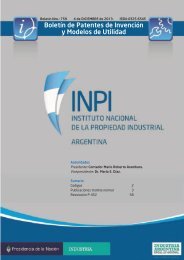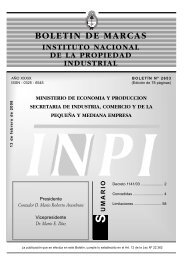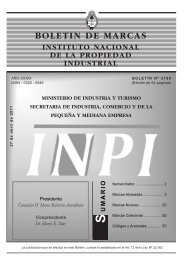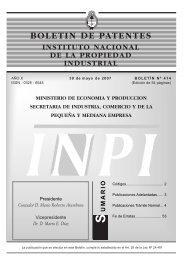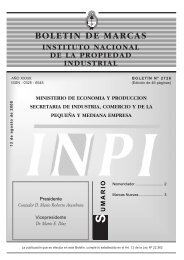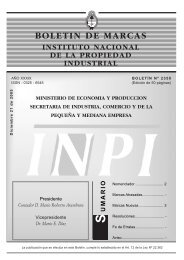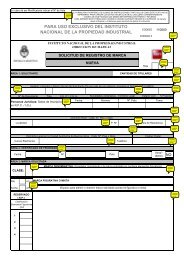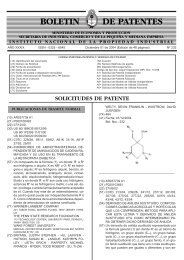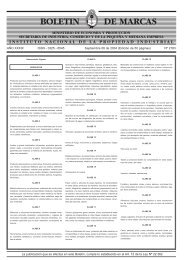2004 - 1 - Ley 24481 - Instituto Nacional de la Propiedad Industrial
2004 - 1 - Ley 24481 - Instituto Nacional de la Propiedad Industrial
2004 - 1 - Ley 24481 - Instituto Nacional de la Propiedad Industrial
You also want an ePaper? Increase the reach of your titles
YUMPU automatically turns print PDFs into web optimized ePapers that Google loves.
proporciones <strong>de</strong> ácidos grasos n-6:n-3 comprendidos<br />
entre 5:1 y 15:1; en <strong>la</strong> cual el ácido palmítico<br />
está predominantemente en <strong>la</strong> posición 2- <strong>de</strong> los<br />
triacilgliceroles y los ácidos araquidónico y docosahexaenoico<br />
están distribuidos entre <strong>la</strong>s posiciones<br />
1-, 2- y 3- <strong>de</strong> los triacilgliceroles.<br />
Siguen 9 reivindicaciones.<br />
(71) Titu<strong>la</strong>r - SOCIETE DES PRODUITS NESTLE S.A.<br />
VEVEY-CH-1800 -, CH-180, CH<br />
(74) Agente 194<br />
(10) Patente <strong>de</strong> invención<br />
(11) Resolución Nº AR011590B1<br />
(21) Acta Nº 19980100404<br />
(22) Fecha <strong>de</strong> Presentación 29/01/1998<br />
(24) Fecha <strong>de</strong> Resolución 03/03/<strong>2004</strong><br />
(--) Fecha <strong>de</strong> Vencimiento 29/01/2018<br />
(30) Prioridad convenio <strong>de</strong> Paris US 08/790134<br />
29/01/1997, US 08/960131 25/11/1997<br />
(51) Int. Cl. A23F 3/40, 5/46, A23L 1/234, 1/48<br />
(54) Título - PROCEDIMIENTO PARA INCORPORAR<br />
UN SUBSTRATO TRANSPORTADOR DE ARO-<br />
MAS A UN POLVO PARA BEBIDA<br />
(57) REIVINDICACIONES<br />
1. Un proceso para incorporar un sustrato transportador<br />
<strong>de</strong> aroma a un polvo para bebida, CARAC-<br />
TERIZADO porque compren<strong>de</strong>: transportar el polvo<br />
para bebida en forma <strong>de</strong> lecho móvil y provocando<br />
que el lecho móvil caiga en forma <strong>de</strong> cortina anu<strong>la</strong>r<br />
a un rellenador para rellenar envases con el polvo<br />
para bebida; y rociar el sustrato transportador <strong>de</strong><br />
arom a al polvo para bebida mientras que cae por <strong>la</strong><br />
cortina anu<strong>la</strong>r <strong>de</strong>s<strong>de</strong> una posición superior al lecho<br />
móvil para obtener una distribución sustancial y<br />
homogénea <strong>de</strong>l sustrato transportador <strong>de</strong>l aroma en<br />
el polvo para bebida <strong>de</strong>ntro <strong>de</strong>l rellenador.<br />
Siguen 8 reivindicaciones.<br />
(71) Titu<strong>la</strong>r - SOCIETE DES PRODUITS NESTLE S.A.<br />
VEVEY-CH-1800 -, CH-180, CH<br />
(10) Patente <strong>de</strong> invención<br />
(11) Resolución Nº AR002775B1<br />
(21) Acta Nº 19960103485<br />
(22) Fecha <strong>de</strong> Presentación 08/07/1996<br />
(24) Fecha <strong>de</strong> Resolución 03/03/<strong>2004</strong><br />
(--) Fecha <strong>de</strong> Vencimiento 08/07/2016<br />
(30) Prioridad convenio <strong>de</strong> Paris EP 95304827.9<br />
11/07/1995<br />
(51) Int. Cl. C10M 141/10, 169/06 // (C10M 141/10,<br />
125:22, 129:58, 135:18, 137:10) (C10M 169/06,<br />
Patentes Concedidas en <strong>2004</strong><br />
Enero-Marzo<br />
<strong>Ley</strong> <strong>24481</strong><br />
117:00, 119:24, 125:22, 129:58, 135:18, 137:10),<br />
C10N 10:00, 10:02,10:06, 30:06.<br />
(54) Título - USO DE DISULFURO DE MOLIBDENO,<br />
NAFTENATO DE ZINC Y UNO O MAS DITIOFOS-<br />
FATOS DE METAL, Y OPCIONALMENTE UNO O<br />
MAS DITIOCARBAMATOS DE METAL<br />
(57) La presente invención se refiere a composiciones<br />
lubricantes que compren<strong>de</strong>n un aceite <strong>de</strong> base <strong>de</strong><br />
origen mineral y/o sintético en combinación con un<br />
aditivo reductor <strong>de</strong> fricción, combinación que compren<strong>de</strong><br />
disulfuro <strong>de</strong> molib<strong>de</strong>no, naftenato <strong>de</strong> zinc y<br />
por lo menos un ditiofosfato <strong>de</strong> metal y opcionalmente<br />
por lo menos un ditiocarbamato <strong>de</strong> metal.<br />
Una grasa lubricante que compren<strong>de</strong> tal composición<br />
en combinación con un espesante, que pue<strong>de</strong><br />
ser un compuesto <strong>de</strong> urea, un jabón simple <strong>de</strong> litio,<br />
es particu<strong>la</strong>rmente a<strong>de</strong>cuada para lubricar uniones<br />
<strong>de</strong> velocidad constante tales como uniones esféricas<br />
<strong>de</strong> velocidad constante. Así, <strong>la</strong> invención se refiere<br />
también a un método <strong>de</strong> lubricación <strong>de</strong> una<br />
unión <strong>de</strong> velocidad constante con dicha composición,<br />
y a <strong>la</strong> unión <strong>de</strong> velocidad constante así lubricada.<br />
(71) Titu<strong>la</strong>r - SHELL INTERNATIONALE RESEARCH<br />
MAATSCHAPPIJ B.V.<br />
CAREL VAN BYLANDTLAAN 30, HR, THE HAGUE 2596,<br />
NL<br />
(72) Inventor – FLETCHER, ROBERT ANTHONY<br />
(74) Agente 108<br />
(10) Patente <strong>de</strong> invención<br />
(11) Resolución Nº AR011662B1<br />
(21) Acta Nº 19980100599<br />
(22) Fecha <strong>de</strong> Presentación 11/02/1998<br />
(24) Fecha <strong>de</strong> Resolución 03/03/<strong>2004</strong><br />
(--) Fecha <strong>de</strong> Vencimiento 11/02/2018<br />
(30) Prioridad convenio <strong>de</strong> Paris FR 97 01848<br />
12/02/1997<br />
(51) Int. Cl. C04B 24/26, 24/20, 28/02, E21B 33/13,<br />
C09K 7/02<br />
(54) Título - AGENTE PARA CONTROLAR LA PER-<br />
DIDA DE FLUIDOS Y COMPOSICION PARA CE-<br />
MENTAR POZOS DE PETROLEO, QUE COM-<br />
PRENDE DICHO AGENTE PARA CONTROLAR LA<br />
PERDIDA DE FLUIDOS<br />
(57) REIVINDICACIONES.<br />
1. Un agente para contro<strong>la</strong>r <strong>la</strong> pérdida <strong>de</strong> fluidos para<br />
una lechada <strong>de</strong> cemento <strong>de</strong>stinada a <strong>la</strong> industria<br />
petrolera (u otra análoga), que compren<strong>de</strong> un microgel<br />
obtenido reticu<strong>la</strong>ndo químicamente un poli(alcohol<br />
vinílico) [PVA], haciendo reaccionar el poli<br />
(alcohol vinílico) en solución con agentes que pue-<br />
41



